-
I, DANIEL BLAKE (Ken Loach 2016)
KEN LOACH: I, DANIEL BLAKE (2016)
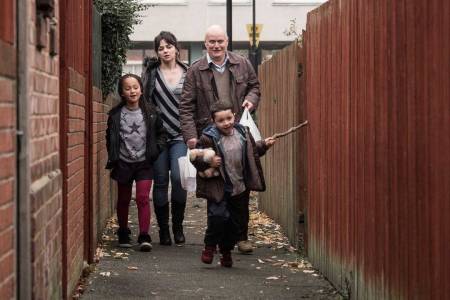
Bureaucracy grinds down
Ken Loach's Cannes Golden Palm winner I, Daniel Blake packs a powerful emotional punch using a neorealist method close to De Sica. Loach's films have become more doctrinaire since he's taken on Paul Laverty as his writer. Their theme is, that in an increasingly money-based, conservative world, as Peter Bradshaw put it in his Cannes Guardian review, "the [British] benefits system has been repurposed as the 21st-century workhouse in our age of austerity: made deliberately grim, to deter or design out all but the most deserving poor." And Loach and Laverty are pretty fucking angry about this. It's not subtle material. But with this kind of economical and plangent filmmaking, you have to be hard-hearted to resist.
Daniel Blake, the everyman exemplar, is a 59-year-old carpenter - played by the disarmingly good and honest looking standup comic Dave Johns - struggling to get public assistance while the state welfare bureaucracy's minions toy with him and ignore who he is. He has had a major heart attack and is on doctor's orders not to work for some months at the craft he has practiced all his life. Some social services "decision maker" misreads a supernumerary questionnaire he oughtn't to have undergone. Or maybe she is getting revenge on him for showing her stupidity angered him. (The first governmental voice, in the opening credits, we never even see.) His status is reversed. He's declared qualified to work, apparently because he can touch his opposite shoulder and put on a hat. Disability payments are denied. He must reapply, and in the meantime to receive funds must inappropriately seek unemployment benefits. For them, he's supposed to spend 35 hours a week seeking jobs he can't take, and prove he has done it. Already it's a Sisyphean Catch-22 situation, and it goes on and on.
Besides this Dan is old-fashioned and computer illiterate and the new system requires many procedures to be performed online. The Internet is not a benefit; it only aids the deliverers of inhumanity to complicate things for decent, deserving folk. Dan has never handled a "mouse" and thinks the "cursor" well-named. Constantly threatened with "sanctions" for not fulfilling requirements, he has to attend a weekend workshop on making a CV whose main thrust is that job seeking is hopeless and employers indifferent. His resulting CV he hand-writes with a pencil. Nonetheless he gets a job offer with it, which of course he can't take.
The best parts of the movie involve distractions from this grim struggle. A touching complication is added when, early on at the social services office, Dan meets and comforts Katie (Hayley Squires), a hard-up single mum with two little kids recently arrived from London, who become a surrogate family for the recent widower Dan. He also has human moments with his young black neighbor, an energetic footballer attempting to make a living under-selling expensive trainers he gets direct from China. Katie's situation and her kids are sad and touching. The story verges on Defoe - Moll Flanders, perhaps.
The bottom line is the solid decency and fight to maintain dignity. We are watching working class people ground down by the state into dire poverty when, with a little help, they could be making a constructive contribution to society. I did not feel here the breathtaking authenticity of Ken Loach's debut film Kes. This hasn't the complexity of the related French film, Stéphane Brizé's The Measure of a Man/La loi du marché (NYFF 2015). But this gets you more in the gut, and of Loach's late phase work (he is now eighty). I, Daniel Blake may be his best. Did it deserve the Palme D'Or? Cannes top awards are often debatable. But Loach deserves recognition for his devotion to rock-bottom social concern and his classic craftsmanship.
I, Daniel Blake, 100 mins., debuted at Cannes 2016 in Competition, receiving the Palme d'Or; also shown at 14 other international festivals, including Locarno, Toronto, New York and Vancouver. Theatrical release in many countries 21 Oct. In France 26 Oct. Screened for this review at UGC Danton, Paris 26 Oct.
US theatrical release begins 23 Dec. 2016 at IFC Center and Lincoln Plaza Cinema.
Last edited by Chris Knipp; 12-14-2016 at 10:40 AM.
-
LA MORT DE LOUIS XIV (Albert Serra 2016)
ALBERT SERRA: LA MORT DE LOUIS XIV/THE DEATH OF LOUIS XIV (2016)
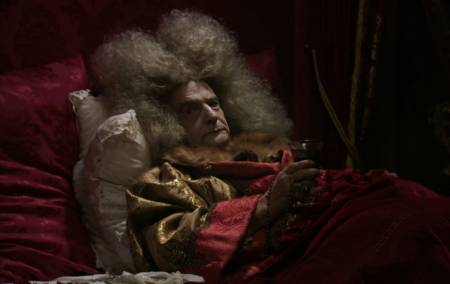
JEAN-PIERRE LÉAUD IN LA MORT DE LOUIS XIV
Léaud dies for us, with authoritative inertia
Serra is working in a similar style to his Casanova film (too much so!) but this time has something concentrated and at times grand - and he has Jean-Pierre Léaud, who if not the "only" person to play the dying king as he's claimed, is a hard choice to better. Being, if not quite near death, still rather worn down myself from lengthy visits to the Centre Pompidou Renée Magritte show, "The Color Line" at the Musée Branly, and the breathtaking but exhausting and mobbed Icônes de l'art moderne show of the Shchukin Collection at the Fondation Louis Vuitton in Frank Gehry's airy bubble palace, I'll refer my readers to the Critics Roundup for Serra's film for a mosaic of salient comments and just add a few of my own.
There, you will see excerpts from Jonathan Rosenbaum, who only hints at why he finds this "gripping" and calls Léaud's performance "exquisite" and "minimalist." "Hell man," Errol Flynn's last words are said to have been, "dyin's easy." And indeed it does not require much motion to die. The quintessentially cinematic Léaud knows to underplay it.
Josh Timmermann of Vancouver is also right: the film is largely about "wrong-headed doctors" and "syncophantic courtiers" - and, I might add, we have seen noble death sequences that emphasized these aspects in historical movies before. This is among other things a reminder of how far medicine has come since 1715. Maybe Leo Goldsmith is right, that Serra was disingenuous in denying the significance of casting Léaud: that his own physical decline is a part of what's moving. Cinephiles know him as the boy in The 400 Blows and the frisky Antoine Doinel. Here he is fat and degenerate-looking. Showing up is 80 percent of life, and Léaud is showing up as Léaud as well as donning the apparel of a dying king, arguably the greatest in history.
Note the comment of Daniel Fairfax in Senses of Cinema: "Very few actors are capable of holding our attention for 100 minutes of screen time while essentially remaining supine throughout the film. Léaud, one of the most captivating figures in the history of film, achieves this feat with ease. His very being is cinematic." Léaud indeed was always completely at home in front of a camera: he knows how just to "be." And dying's "easy" (in Flynn's dying words) because it's passive. This is what makes the experience of the film both grand and tragicomic. The king's accoutrements are noble - the cloths, the gilt, the big fuzzy wig, Léaud's now imposing schnazz, the team of doctors, courtiers, and servants; but his passivity and his predicament are sometimes humiliating, or even comic.
Technically, and economically, Serra makes the film intensely claustrophobic. Though he shows us the plotting, conniving entourage, he builds a series of relentless closeups and immobile shots echoing the king's own inability for most of the film to get out of bed.
Several writers refer to Roberto Rossellini's historical neorealist film for French TV The Taking of Power by Louis XIV, that bright and energetic, this dark and gloomy (and, like the Casanova film, seems embalmed in molasses, which makes this, despite what some critics say, not a film of mainstream as well as festival/cinephile appeal). But they have a kinship too, because Serra's approach verges on neorealism, a cinematic approach to history deep into physicality and uninterested in narrative or making "points." The accoutrements are nice, but the history you'll have to read up on for yourself. He also spares us many disgusting details, however, that a more conventional modern film might have included.
Whatever adjectives we apply to Serra's film, grand, strange, melancholy, elegant, it is a dark, moody, highly crafted yet experimental memento mori, a reminder that death is the great leveler. It is also, as the eternally hard-to-please Cahiers du Cinéma observes, "vaguely beautiful, but above all very boring"! Le Figaro calls Léaud's performance "fascinating and monotonous." It's a waxworks tour de force: for very long takes, in the final dying phase he just barely moves, then does not move at all. Watching kings die is thought-provoking, but it's also, at times, like the proverbial watching paint dry.
La mort de Louis XIV, 115 mins., debuted at Cannes. It won the Prix Jean Vigo 2016 (feature film) and at Cannes Jean-Pierre Léaud was given a Palme d'or d'honneur, a fitting recognition of the legendary actor whose performance here signals twilight years (he seems older than his actual 72); 14 other international festivals including Toronto, New York, Vancouver and London. French theatrical release 2 Nov. 2016 to extremely favorable reviews (AlloCiné press rating 3.9/5 based on 22 reviews), but note the negative comments I've cited. Screened for this review at MK2 Hautefeuille AKA Côté St-Michel, Paris, 3 Nov. 2016.
Last edited by Chris Knipp; 04-18-2017 at 07:24 PM.
-
BILLY LYNN'S LONG HALFTIME WALK (Ang Lee 2016)
ANG LEE: BILLY LYNN'S LONG HALFTIME WALK (2016)
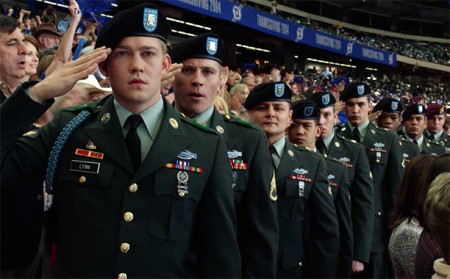
Acid trip at 120 frames?
Ang Lee's film adapted from the bestseller Billy Lynn's Long Halftime Walk was one of those later inspirations of the New York Film Festival, chosen after the Main Slate had been selected to be featured as a glitzy festival premiere. Lee's Life of Pi four years ago, a similar NYFF collaboration, was, similarly, technically innovative and a glitzy premiere. But that one was more successful, and made more sense in the first place.
Motion capture CGI of animals enabled Lee to film Yann Martel's unfilmable sea odyssey - that zoo-full of escaped animals, that saga on a lifeboat with a Bengal tiger could never have been visualized before this technology. Maybe Ang Lee's Life of Pi isn't deep, but it's a glorious adventure. This time Lee wanted to try out a different innovation, shooting at a zillion frames a minute (actually 120 fps) to achieve a hyperreal visual effect augmented with 4K and 3D. The trouble is that most movie theaters haven't the technology to project the film as it was made and shown at Lincoln Center. So it just looks like any other film, which may be for the best. Was this technical experiment necessary?
I like this film, mainly because I like the star, young English actor Joe Alwyn, who plays Billy. He tremendously holds the screen. I can also see what's going on in Ben Fountain's novel as adapted by Jean-Christophe Castelli, even though at the end, you go, "Is that all?" Something is missing - the deeper ironies, postmodern media savvy, and emotional complexities of the book. This lack remains, despite higher resolution and filming everything, the heroic Bravo squad's and Billy's long day as patriotic mascots at a big Texas Thanksgiving football game, as he, especially, flashes back to the war in Iraq they've just come from, and are soon going back to. All that can't make up for what doesn't get to the screen from the book.
Billy's heroic exploit, as it's seen (he says he's not a hero, just a soldier) where he tried to save his beloved guru and mentor 'Shroom (a sweet, philosophical Vin Diesel) in a fire fight, was filmed and the nation saw it, so Billy, who got a Silver Star, is famous. The Bravo group has been on a boozy, tacky victory tour for two weeks, and have just now come to Billy's home state of Texas, where his sister Kathryn (Kristen Stewart, excellent and totally unglamorous), only now recovering from a terrible car accident, who loves Billy and hates the war, wants him to use his special status to claim PTSD and get out of combat. And he considers this. He's also a virgin, and he falls for a classy, Christian cheerleader, Faison (Makenzie Leigh), who wants him. Meanwhile the squad is surrounded by handlers and the oily football team owner, Norm Oglesby (Steve Martin), and a movie deal is spoken of. All this is going on, and then comes the halftime show where the squad is on display with Billy in front.
Joe Alwyn is a physically impressive young man, and his big, boyish, almost babyish face, big blue eyes and big smile are riveting. The conceit of the story is that the halftime show, with its fireworks and explosions and loud drum rolls and being within two feet of a prancing singing Beyoncé, brings back that day of combat to Billy, not for the first time, but at higher intensity and greater length, down to his hand-to-hand killing of an Iraqi and him and his sergeant Dime (Garrett Hedlund) falling into each other's arms when they know 'Shroom is dead for sure.
The logic of the hyperreal imagery Lee worked for seems this. The boys wake up with a hangover that morning, particularly Billy, who asks for Advil all through, but gets it only after everything is over. They do some drinking, and they smoke some dope. Just civilian life, which now seems more chaotic than the front, but above all this overblown crazy outpouring of American kitsch, must seem to the squad, and to Billy, like an acid trip. The amped-up clarity of images was a way of expressing that - though unlike the motion capture CGI for the Bengal tiger, it wasn't really necessary, and reliance on the images, and recreation of the chaotic stadium scene and of scenes from the squad's Iraq experiences, down to the face of a boy when they take away his father in a night raid of a house - though all this is impressive and memorable, just may not have been quite what Ben Fountain was getting at in his book.
I haven't read the book, but I want to. It's been called "the Catch-22 of the Iraq war," and that's good enough for me. It's obviously a hard look at modern combat, the intimacy among soldiers, the morality of the "war on terror," heroism vs. doing your job, and the way America looks at war and at its soldiers. The latter, though central, is largely only implied in the movie. Tellingly, Billy says he can't understand why he is being celebrated for "the worst day of my life." Once again as so often happens with a film adaptation of a complex book, one feels deprived. I'm also not convinced the normally gentle and peaceful (and must I point out, Taiwanese, not American?) Ang Lee was the man to direct such a movie.
Yet many of the cast members are fine, starting with Alwyn, whose power to express Billy's gentle dignity goes beyond words, continuing with Garrett Hedlund in one of his best performances as the brisk, ironic but moral Dime; Kristen Stewart, so caring, yet so bitter, as Billy's sister; and each of the squad members, Arturo Castro as Mango, Mason Lee as Foo, Brian 'Astro' Bradley as Lodis, Beau Knapp as Crack, Ismael Cruz Cordova as Holiday, and Barney Harris as Sykes, strikes the right note, and their ensemble work evokes military camaraderie perfectly. Steve Martin seems a bit out of his depth, but it's Joe's movie. That face, and that smile, you swim into. His Billy is confused, at a loss - here - but always gives the right answer. You can believe this rude boy in his Texas youth has become a brave leader in combat. But again, I think Ben Fountain was saying more than that, and so this movie, for all its visual glamour, is a little shallow. Obviously Alwyn will be back, and I look forward to his two films being completed for release in 2017. (I've relied on Theo Tait's description of the book in his July 2012 Guardian review. I note that Todd VanDerWerff describes the original 120 fps 4K 3D version as a "gorgeous calamity." He suggests that maybe the one time where the hyperreal visuals he saw at Lincoln Center really click in the film is when, during the halftime show, Billy's perceptions suddenly morph back and forth from fireworks to firefight - when the acid trip effect shows us his PTSD in effect. And that could be. But most viewers will never see it.)
Billy Lynn's Long Halftime Walk, 113 mins., debuted 14 Oct at the NYFF. Screened for this review in regular 2D format at small cineplex auditorium in Emeryville, California 22 Nov. US release 11 Nov.; UK, 10 Jan. 2017.
Last edited by Chris Knipp; 11-23-2016 at 09:21 AM.
-
MANCHESTER BY THE SEA (Kenneth Lonergan 2016)
KENNETH LONERGAN: MANCHESTER BY THE SEA (2016)
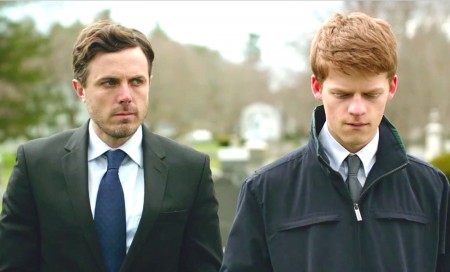
CASEY AFFLECK AND LUCAS HEDGES IN MANCHESTER BY THE SEA
Harrowing fun in New England winter
There is a lot of raw emotion in Kenneth Lonergan's Manchester by the Sea that makes it real and, by fits and starts, original. The material isn't new at all - a depressed ne'er-do-well given to barroom brawling, a teen who loses his dad, a couple split by tragedy - but the handling of it shows Lonergan's touch, and the acting is sometimes splendid, nearly always on the part of Casey Affleck, as the ne'er-do-well, and Lucas Hedges, as the bereaved teen, and theirs is the central relationship. There is a lot going on, but it all revolves around them. This is a complex and enjoyable film, despite its grimness; it's both flawed, and brilliant. It's a little too long, and some of the music is annoying. But it's splendid stuff, full of wonderful scenes and memorable small touches you want to watch again. Its high praise is deserved.
Lee Chandler (Affleck) is a janitor in a suburb of Boston. It is winter, and Massachusetts in winter is the setting for events. The film has a love affair with Essex County, the northeast corner of the state, boats and fishing, dry New England mindsets, and the accompanying snowy landscapes, which dp Jody Lee Lipes captures with a cool beauty in panoramic shots that punctuate the action. The film has a very keen sense of place, which always helps make emotion feel authentic.
The early part of the film is a grim, somewhat humorless comedy, Lee dealing with crabby tenants and their little problems. That is mere prologue, and he's soon back in his hometown (named in the title) dealing with the death of his older brother Joe (Kyle Chandler) from a premature case of congestive heart failure - then with being, without prior warning, made responsible for Patrick, Joe's now 16-year-old son (Lucas Hedges, who offhandedly nails his every line, and has some zingers).
As Lee's told this by the lawyer, the scene is intercut with an elaborate flashback exposition, a little over an hour into the film, of a tragedy that in a sense kills all suspense and lays out the facts too bluntly: when Lee says he can't move back here to care for Patrick, we may know why better than he could articulate.
The film is at once very funny and very sad. For the time being, though Lee fights the idea of being Patrick's custodian and of moving back, he is in charge of the boy, and it soon emerges that Patrick has more of a life than Uncle Lee. He's on the hockey team and another team (he's playing hockey, violently, when he gets the news of the death), he has two girlfriends, he's in a band. He is a darling of the ladies. He wants to keep his father's fishing boat, though the engine is giving out. He wants to finish high school with his friends; he has a lot of them. Lee is a maintenance man. Why should Patrick move to Boston? He also hates the idea that because it's a cold winter, his father's body is to be kept under refrigeration in Beverly, where the funeral home is, till spring when the ground is thawed and he can be buried in the cemetery in Manchester.
This is a story of responsibility thrust upon one unsuited to it, not unlike the subject of Lonergan's memorable debut film You Can Count on Me. Casey Afffleck shines as he embodies a terrible loser who yet has a lot of heart, whose aspiration to do the right thing takes on a quietly tragic dimension. Skirting on the edge are other memorably flawed individuals. Michelle Williams delivers a searing performance as Randi Chandler, Lee's ex-wife. There is a random encounter between Randi and Lee near the end that Mike D'Angelo says is so "emotionally harrowing and in such a radically unconventional way" that the prospect of "enduring" it a second time frightens him, even though he wants to watch the film again in hopes that the flashbacks, particularly of the tragedy, will make sense as more than mere exposition. These flashbacks in fact, though powerful, don't seem inserted with commanding logic. The late Joe Chandler's wife (Gretchen Mol) is a recovering alcoholic with a very Christian new husband (Matthew Broderick) and a shaky hold on normalcy and sobriety. She tries to come back into Patrick's life and he hopes this could be his safe haven.
Patrick uses pizza, his pals, and his two girlfriends innocent of each other's existence, whom he's trying to bed, with uneven success, to numb the pain of losing his exemplary father. He only breaks down once, memorably. That is one of many scenes where Lonergan wonderfully skirts the edge between raw and funny that characterizes some of life's most difficult moments. There is originality and intelligence in the focus on this edge, which makes us watch each scene with fresh eyes. Casey Affleck is from Massachusetts, and he has the quintessentially New England voice - dry but with a little break in it - that conveys depths of hurt under a tough facade with almost every line.
The movie doesn't end very satisfactorily. It takes us through a lot of very good stuff, and then offers a resolution that's almost an afterthought . But there is just a wealth of fine material here.
Manchester by the Sea, 137 mins., debuted at Sundance Jan. 2016; 17 other festivals, including Telluride, Toronto, New York, Vancouver and London. Theatrical release 18 Nov 2016. Screened on West Coast release 25 Nov. France 14 Dec., UK 13 Jan. 2017. An Amazon Studios Release. Ranking very high in ratings, Matacritc 96%, second only to Moonlight (99%).
Last edited by Chris Knipp; 11-23-2018 at 04:04 PM.
-
JACKIE (Pablo Larraín 2016)
PABLO LARRAÍN: JACKIE (2016)

NATALIE PORTMAN IN JACKIE
A glitzy simulacrum of great events
By bringing out two movies in one year, one in English with Hollywood stars, Chilean director Pablo Larraín shows his ambition - and he's overreaching. His Neruda is a surreal fantasy about his country's most famous literary figure, with Gael García Bernal, left over from his earlier No (where he first started to lose inspiration), running around as a dapper little detective. Jackie is a project that's equally ambitious - perhaps in global terms, more so. It 's about a major, shocking event in American history. It's also another Oscar bid for its star, Natalie Portman, who does an impersonation of Jacqueline Bouvier Kennedy, the look, the manner, the voice.
And yet nothing Larraín has done since has equaled the dark, creepy performances of the great Chilean actor Alfredo Castro and the director's admirably pessimistic second and third films, Tony Manero and Post Mortem. As the filmmaker's reputation has soared, the originality of his work has diminished. Jackie is a flashy effort, as audacious as it is accomplished. And yet, if you look closely, it is contains no revelations. Like many movies, it's essentially a play, with unusually beautiful and realistic visuals that do not add to the meaning.
It's a bold move on Larraín's part to switch to English with filming the Kennedy assassination and its aftermath from the point of view of Jacqueline Kennedy, and the look of the whole film glitters through the brilliant work of cinematographer Stéphane Fontaine, who worked with Jacques Audiard, with Matt Ross on Captain Fantastic, and recently on Verhoeven's Elle. In a sense the ghoulish, Madame Tussaud attention to detail fits will with Larraín's early films. The waxworks realism alternates with moments that are sometimes surreal, weaving together diverse scenes. Editing juggles back and forth between a flashback simulation - but all of this is simulation - of Mrs. Kennedy's hour-long black-and-white TV tour of the White House, seen as stilted and almost comically nervous; the moment of the shooting in the motorcade in Dallas, the blood-spattered pink Chanel suit that she refused to take off for the photographers ("I want them to see what they've done"); the hours between the autopsy and the funeral; a later meeting with an Irish Catholic priest (John Hurt); and, in an understandable but still probably pretty unwise (and awkwardly executed) frame tale of historian Theodore H. White's lengthy interview with the widow at Hyannis Port for Life magazine a week later. The bloody, explosive moment of the killing and the interment at Arlington National Cemetery are saved for the last minutes. If you consult White's notes of the actual interview, Mrs. Kennedy actually launced into gruesomely vivid detail of spattered blood in its first moments, but not in the film version.
But the revelation - that "Jackie" paid a lot of attention to how history would view her husband and the style of his departure, such as the Lincoln-style horse-drawn bier and the funeral procession on foot behind it, and the dramatic location of JFK's grave on an Arlington hill apart; and overall her desire that the Kennedy administration be seen as a kind of "Camelot" - just isn't a revelation at all, even though details of the White interview weren't revealed till a year after the death of Mrs. Onassis. It's just what everyone knows who has the slightest knowledge of the events. The movie saves for last "news" that lands with a thud.
What the movie does extraordinarily well is the trappings. The furniture, above all the upholstery, and all the decor of the White House and Hyannis Port look just right. The early-Sixties clothes of both the men and the women seem flawless, except for White's inappropriate loose tie for the interview (that would never have been). Larraín also recreates photographs of the Johnsons and Kennedys and the whole funeral, down to Caroline and John-John walking down the stairs with their mother.
Portman will be congratulated for her recreation of the First Lady's voice and accent. Unfortunately such efforts are doomed to failure. She can't get the lady's beauty, elegance, and inner calm, or the subtly concealed insecurity behind that facade.
The film justifies its focus by reflecting, as again we know who have followed these events, that Jacqueline Kennedy behaved with courage and authority under stress. The most impressive note is her anger. It's hard to know what the family will think of the montage in which she wanders the White House in a string of fancy outfits drunk and stoned on pills and listening to the "Camelot" record, or how much the real Jacqueline cried or didn't cry. It's impossible not to link this performance by Natalie Portman with her Oscar-winning turn in Darren Aronofsky's over-the-top psychological thriller Black Swan. The connectioin explains why Portman seems to be trying too hard at many points. She was not, like her subject, to the manner born. She does a plucky job. She's literally not big enough for the role.
Jackie is a glitzy cinematic bauble. It gets right so many of the things a movie can get right about a time and place. But its revelations are empty. And whether or not Natalie Portman pulls it off, other actors are at best approximate. Peter Sarsgaard isn't right at all as Bobby Kennedy. Greta Gerwig is so well disguised it hardly matters, though she's an odd choce for social secretary Nancy Tuckerman. John Carroll Lynch looks more like a thug than Lyndon Johnson, Beth Grant is barely close Lady Bird Johnson. Billy Crudup isn't even billed as Theodore H. White, only "The Journalist," but his character is too bold and aggressive. So it goes. This is a simulacrum whose accuracies only show up how far off it is from the real thing. Maybe next time Larraín will do something lower key and more authentic. He has our attention.
Jackie, 99 mins., debuted at Venice 7 Sept. 2016; 14 other festivals including Toronto and New York. US Theatrical release beginning 2 Dec. UK 20 Jan. 2017. Metacritic rating 80%.
Last edited by Chris Knipp; 12-11-2016 at 07:23 PM.
-
PATERSON (Jim Jarmusch 2016)
JIM JARMUSCH: PATERSON (2016)
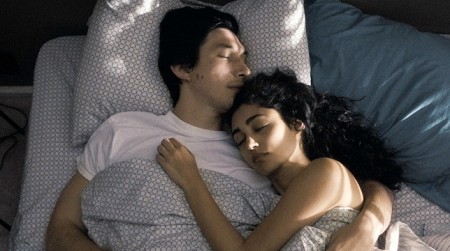
ADAM DRIVER AND GOLDSHIFTEH FARAHANI IN PATERSON
Magic of the quotidian
Paterson both is and isn't a typical Jim Jarmusch film. It has little touches that are distinctively his. His hermetic onscreen world, infuriating to some, is present here, notable in the controlled environment and repetitive structure. But this isn't a wry comedy with a hipster angle. It has its little running jokes, but on the whole it's deadpan. It's more like a little study in the nature of everyday life. It's humble. It's rather zen. It's organized into chapters, each one a day, chronicling a week or so in its characters' lives. It's a quiet tale of life and art, and also most certainly of love. Like most movies where nothing happens, it's hard to describe. It has hardly any big incidents (maybe two medium ones, one of which is, admittedly, a shocker), but there is a multiplicity of small ones. What they add up to is revelation and quiet pleasure.
Its protagonist is a modest man, a humble working-class guy. But he's a quiet giant. He may have the answers, but he would not boast of that. And he's a poet, of sorts. Every day he adds to the little fund of free verses he has penned into "secret notebook" he takes with him to work. He is a bus driver (played by Adam Driver). His name is Paterson. To make it simpler (and more hermetic, more like a poem) he also lives in Paterson (New Jersey), the home of the notable American poet, William Carlos Williams, who wrote a long poem, published over time in five volumes, called Paterson. (Allen Ginsberg also came from Paterson.) On the front of the bus he drives the destination reads simply, "Paterson."
Paterson has a live-in girlfriend, Laura. Laura and Paterson are in love. When he wakes up beside her every work day at a little past six he looks at her lovingly, kisses her, and they exchange sweet words. Laura is played by the beautiful, multi-lingual actress, Golshifteh Farahani (who's already delivered impeccable performances in Farsi-, French-, and English-language films). As Laura discovers, the Italian poet Petrarch, who perfected the sonnet, wrote a famous poem sequence dedicated to a beloved named "Laura." She thinks Paterson is a fine poet, and she wants him at least to copy the poems, which exist now only in his notebook.
Paterson's Laura is a creative homebody, in the house most days with Marvin, their English bulldog. When he comes home from work Paterson takes Marvin for a walk, in the course of which he tethers Marvin and stops at a bar whose black owner (Barry Shabaka Henley) is named Doc. At the bar he drinks a beer and talks of this and that with Doc and the occasional customer. We learn, for instance, that the most famous citizen of Paterson was the comic Lou Costello (of Abbot and), and there's a park named after him there. Paterson also has a waterfall, and Paterson and Laura have a little picture of it on their wall.
Every day at work Paterson sees Donny (Rizwan Manji), an Indian-born colleague who has lots of complaints. When he asks Paterson how he is, Adam invariably answers, "I'm okay." On the bus, he overhears conversations among passengers, including a young couple who consider themselves the only anarchists in the town. When Paterson gets home, carrying his lunch pail, he pulls the mail out of the mailbox. It's always tilted askew on its pike, and he straightens it. One of the best visual jokes is connected with this.
Laura loves black and white, and has painted and decorated the house with circular designs in those colors. She has two big (for her) projects that develop during the week. One is baking cupcakes for a farmers market on Saturday. They are decorated in different circular patterns of black on white. The other is to become a country singer. This requires her to send away for a guitar and DVDs of guitar lessons. The guitar is called the Harlequin. It's decorated in black and white. When they go to a movie, it's black and white - The Island of Doctor Moreau, with Charles Laughton. (Jarmusch's classic early films were also, of course, black and white.)
But all these details are banalities - except perhaps Paterson's poems: but they too tend to the banal. They're in flat, ordinary language, and they chronicle the quotidian. But they are written by a real poet, Ron Padgett, 74, a poet of the New York school, referred to in the movie (they also resemble those of William Carlos Williams). As Paterson composes them in his mind and writes them down in his notebook, the text appears across the screen.
Toward the end, Paterson suffers a setback, but he moves forward.
Essential to the success of this film is the performance of Adam Driver in the lead. Recently Driver has emerged as an actor of note: The NYFF devoted "An Evening With. . ." to him, as to Kristen Stewart, also much noted of late (she was in three 2016 NYFF films). Driver was in the Lena Dunham series "Girls" from 2012 and has been in films by the Coens, Noah Baumbach, and Jeff Nichols. Currently he is also in Scorsese's Silence beside Andrew Garfield, and he's in "Star Wars." His odd gawky face, tall, broad-shouldered body, deep voice help underline an openness and appeal that have never been better displayed before Paterson where he achieves an understated purity that is most appealing and, one might say, instructive.
The effect of Paterson is, and is intended to be, to celebrate the poetry of everyday life, focused in Paterson and Laura's love for each other, and their happiness with their ordinary days. Its repetition of days is like a series of stanzas and refrains. The film itself is a poem, and in its repetitiousness and bold simplicity Jarmusch has achieved something beautiful. At the time of its Cannes Competition showing, the Nouvelle Observateur critic Pascal Merigeau called it "an absolute marvel."
Paterson, 118 mins., debuted at Cannes 2016, to acclaim, and shown at at least 26 other international festivals including Toronto, New York, Mill Valley and London. US theatrical release began 28 Dec. 2016. Its current Metacritic rating is 90%. Screened for this review on its opening day in San Francisco at the Landmark Embarcadero Cinemas, 6 Jan. 2017.
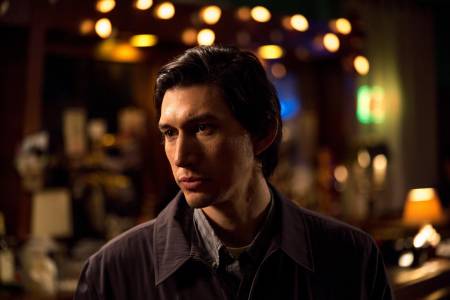
ADAM DRIVER IN PATERSON
Last edited by Chris Knipp; 01-08-2017 at 01:42 AM.
-
THE REHEARSAL (Alison Maclean 2016)
ALISON MACLEAN: THE REHEARSAL (2016)

KERRY FOX, JAMES ROLLESTON IN THE REHEARSAL
Playacting too close to real
The Rehearsal is Alison Maclean's long-delayed sequel to her 1999 debut Jesus' Son. While that adapted Denis Johnson's linked story collection, this one is a free screen version of Mann Booker winner Eleanor Catton’s technically playful debut novel. The story about an Aukland acting "Institute" and its untoward interactions with a neighborhood scandal is a slow-burning ensemble piece. It has an admirably fresh and unpredictable quality.
Students at the Institute most work through the year to create and stage a joint end-of-term production that can not only blow away their demanding lead teacher Hannah (Kerry Fox of Shallow Grave, Bright Star) as drama but impress her and visiting talent scouts with participant students' individual skills. Likewise this ensemble movie impresses as a study of local society and a school, but highlights a few main characters, chiefly Hannah, with her Method brainwashing and tough love, and one student she likes, soft, coffee-colored eye candy Stanley (James Rolleston, who's already starred in three films, Boy, The Dark Horse, and The Dead Lands). Stanley is a handsome (or more accurately pretty) young Maori-heritage (in the story would-be) actor.
The Rehearsal is an intriguing mix of emotional and cool, like an actor who can engage an audience without personally losing it - perhaps like Stanley. It resembles a classier version of "Fame," but is unusual not only in its clear-headed look into how acting works but in being a New Zealand film whose offhand complexity has found it a place in some of the biggest international film festivals.
During early class exercises Stanlay comes off as hopelessly bland and without feeling, unable to access emotion or theatrical effects. But he turns out to be quite otherwise. It's a growing surprise when Stanley does show talent and access emotion - initially through channeling his macho dad in a class improvisation where he tells a dirty joke and comes on to Hannah. She likes.
In contrast when his mercurial housemate and pal William (Kieran Charnock) just tells a jokey family story to the class about a spoiled lamb roast that avoids real emotional revelation, Hannah creams him and he's devastated. Basic lesson: if you can't access deep feeling or aren't strong enough to be vulnerable, maybe you can't be an actor at all. Or maybe arts schools profs should be more careful about crushing young artistic spirits.
So that's one of a number of angles. Another, a key focus, is the term-end project. For it. Stanley gets the idea early on of depicting a tennis instructor who seduces his 15-year-old student Victoria (Rachel Roberts), a new local scandal. What he holds off revealing to the class or to her, is that he knows the story first hand, because he's dating Isolde (Ella Edward) Victoria's slightly older sister whom he met on a bus when coming to town. And come to think of it, Isolde is underage to Stanley, so he may be no better than the tennis coach. The story plays with a lot of these angles, delving into group sexual and teen personal issues and jumping around in a somewhat experimental way. And, if it seems too scattered it does end up with a great final musical segment.
The Rehearsal, 102 mins., debuted July (NZIFF), Aug. Sept., and Oct. in subsequent festivals including Toronto, New York, and London.
Last edited by Chris Knipp; 01-10-2017 at 03:40 PM.
 Posting Permissions
Posting Permissions
- You may not post new threads
- You may not post replies
- You may not post attachments
- You may not edit your posts
-
Forum Rules





 Reply With Quote
Reply With Quote







Bookmarks